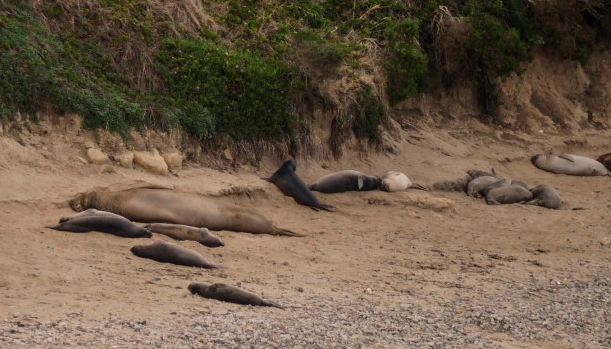
Elephant Seals at Point Reyes National Seashore / Erika Zambello
The first time I visited Point Reyes National Seashore, the Elephant Seals became an instant highlight. Viewed from an overlook near Chimney Rock, we peered down at their bronze forms through binoculars.
At the time, I wrote: "The male Elephant Seals are huge, and I was happy to watch them at our safe distance. Think Elephant Seals have deep, reverberating calls? Think again! Loud they are, but their calls are high-pitched, and almost whiny. The noise was actually hilarious, and we couldn’t stop laughing at their lounging shapes."
As the National Park Service continues to assess the impacts of the government shutdown, they've discovered wildlife responded in unexpected ways.
For decades, the Elephant Seals have occupied their beach and visitors sunbathed and swam on another. Without rangers and park staff keeping the seals from the "human" designated beach during the shutdown, the animals eventually took over the dryer, flatter habitat. During the shutdown, the seals gave birth to over 30 pups, and the beach and access road are now closed.
However, Point Reyes staff have decided to view this change of venue as an opportunity. Rangers will lead tours near the beach, providing educational information and a chance to see the magnificent creatures up close. I know that as a visitor, I would have signed up to see the new pups!
Elephant Seals remain a conservation success story. According to the park website: "After being absent for more than 150 years, elephant seals returned to the sandy Point Reyes Headlands in the early 1970s. In 1981, the first breeding pair was discovered near Chimney Rock. Since then, researchers have found that the colony is growing at a dramatic annual average rate of 16 percent. Fanning out from their initial secluded spot, the seals have expanded to popular beaches."



Comments
Good for the elephant seals! The NPS should just let them take over this beach. I'm OK with roping off a little bit more of the beach if it helps toward a fully recovered and healthy marine mammal population. Over the long term, a spectacular elephant seal colony may draw more visitors anyway, and there's still plenty of beach north and south without seals for people to use.
Hooray for the seals! I visited Drake's Beach a couple of years ago and there was an elephant seal pup on the beach. It looked like a log! Great camouflage1 I photographed it from a safe distance and continued on my walk. When I returned, 2 tourists were harassing the poor thing, standing right over it. It made me so angry. I sympathize with the seals. I'm glad the elephant seals claimed their space so dramatically. Hope they live long and prosper!
Hmm...wondering if the Elephant Seals have taken over Drake's Beach or Limantour Spit. Either way, they should provide another prey source for the Great White Sharks which frequent that area. I lived there back in the 1970's before Elephant Seals discovered the area and the Great Whites fed primarily on sea lions and harbor seals.